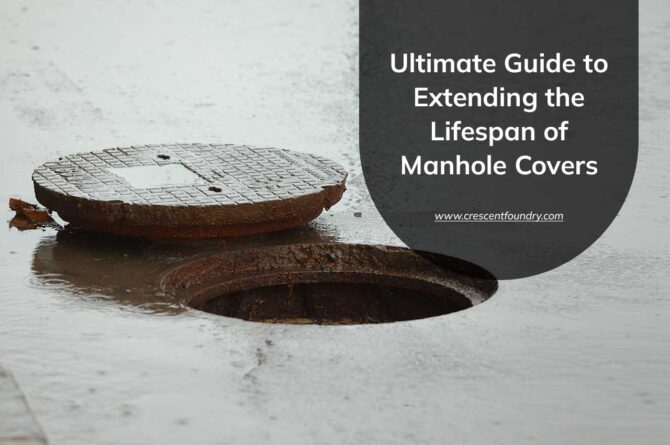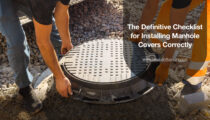Manholes are undoubtedly one of the most important civic amenities.…

Ultimate Guide to Extending the Lifespan of Manhole Covers
Manhole covers are the backbone of an urban infrastructure, safeguarding underground utility networks and ensuring smooth pedestrian & vehicular movement above. However, the durability of manhole covers can often be compromised due to corrosive elements or heavy traffic, raising safety concerns for the urban structure. Hence, it is important to keep several important factors under consideration, like the material combination or maintenance techniques and proactive measures to ensure superior longevity of these essential urban assets. In this blog, the crucial strategies and best practices to enhance the resilience and durability of manhole covers will be explored which are highly practised and recommended by the best manhole cover manufacturers in the USA.
Factors affecting the lifespan of manhole cover:
A manhole cover’s lifespan is impacted by numerous key factors that interact to determine its functionality and durability. Corrosion is a significant factor that occurs due to exposure to moisture, and environmental and chemical contaminants, manipulating the lifespan of a manhole cover. Over time, the structural integrity of the cover is weakened which may lead to safety hazards and potential failures. Furthermore, the continuous strain from heavy traffic volumes accelerates the deterioration of the covers and their supporting frames, particularly in high-traffic or industrial zones. This includes dynamic loads from moving vehicles as well as static loads from cars parked above, both of which can result in deformation and cracking.
The quality of installation and maintenance is another major factor that contributes to determining the lifespan of a manhole cover. Improper installation, including insufficient support or inadequate bedding, can cause structural issues and premature wear. Proactive maintenance and regular inspection, like lubrication, cleaning, and sealing, are important in terms of identifying and addressing such issues initially before they escalate and result in safety hazards.
Must Read: How Hydraulic Manhole Cover Speeds Up Infra Maintenance
Choosing the right material:
It is crucial to choose the right material to ensure the longevity of a manhole cover. According to manhole manufacturers in the USA, cast iron is considered as the best material for manhole covers due to its strength and durability. Excellent corrosion resistance is exhibited by cast iron, particularly when coated with protective materials such as epoxy or bitumen, apart from being versatile and low-maintenance. Moreover, its ability to withstand heavy traffic loads without cracking and deformation makes it a reliable choice.
Regular inspection & maintenance:
Regular maintenance and inspection are crucial to ensure a prolonged lifespan of manhole covers. Frequent inspections assist in identifying potential damage early on, such as corrosion or cracks, enabling prompt repairs. It is important to clean debris, lubricate moving parts, and apply protective coatings to help limit corrosion and damage on manhole covers, ensuring their prolonged durability. Prompt repairs are also crucial based on inspection findings to ensure continuous functionality and further resist potential accidents. Municipalities are mainly responsible at this stage to ensure the long-lasting functionality of manhole covers. They can greatly increase the lifespan of manhole covers and improve overall safety and dependability in urban environments by implementing routine inspection and maintenance procedures into infrastructure management practices.
Upgrading techniques:
Upgrading techniques for these urban assets involve innovative solutions to enhance their performance and durability. This entails using stronger materials or reinforcements to retrofit older covers, applying corrosion-resistant coatings to prevent rust, and utilising cutting-edge technologies like Internet of Things (IoT) sensors for real-time monitoring.
Environmental considerations:
Environmental factors that determine the lifetime of manhole covers involve choosing durable materials that help reduce replacements and minimise resource consumption and waste. Utilising corrosion-resistant coatings minimises chemical runoff into the environment. Proactive maintenance ceases spills and leaks that could degrade the quality of the soil and water. At the end of a cover’s lifecycle, proper disposal or recycling techniques help to further minimise its impact on the environment. Municipal officers and infrastructure managers can contribute to sustainable urban development by prioritising the longevity of manhole covers and promoting eco-conscious practices related to them. Thus, it is possible to reduce overall environmental footprints and facilitate a healthier urban eco-system for communities.
Conclusion:
In the end, it can be stated that efforts to extend the lifespan of manhole covers are important for sustainable infrastructure of an urban environment. By prioritising proactive maintenance, material selection and regular inspection, it is possible to ensure a safer urban infrastructure for communities, while minimising costs and resource consumption. By putting these tactics into practice, infrastructure management becomes more resilient, long-lasting, and environmentally friendly.





